A true classic, my Pound Cake recipe is simple (only six ingredients) and satisfying! This cake is heavy and dense (as it ought to be!) while simultaneously being soft, buttery, and absolutely melt-in-your-mouth! It’s incredible served alone or pairs beautifully with whipped cream and fresh fruit. Recipe includes a how-to video!
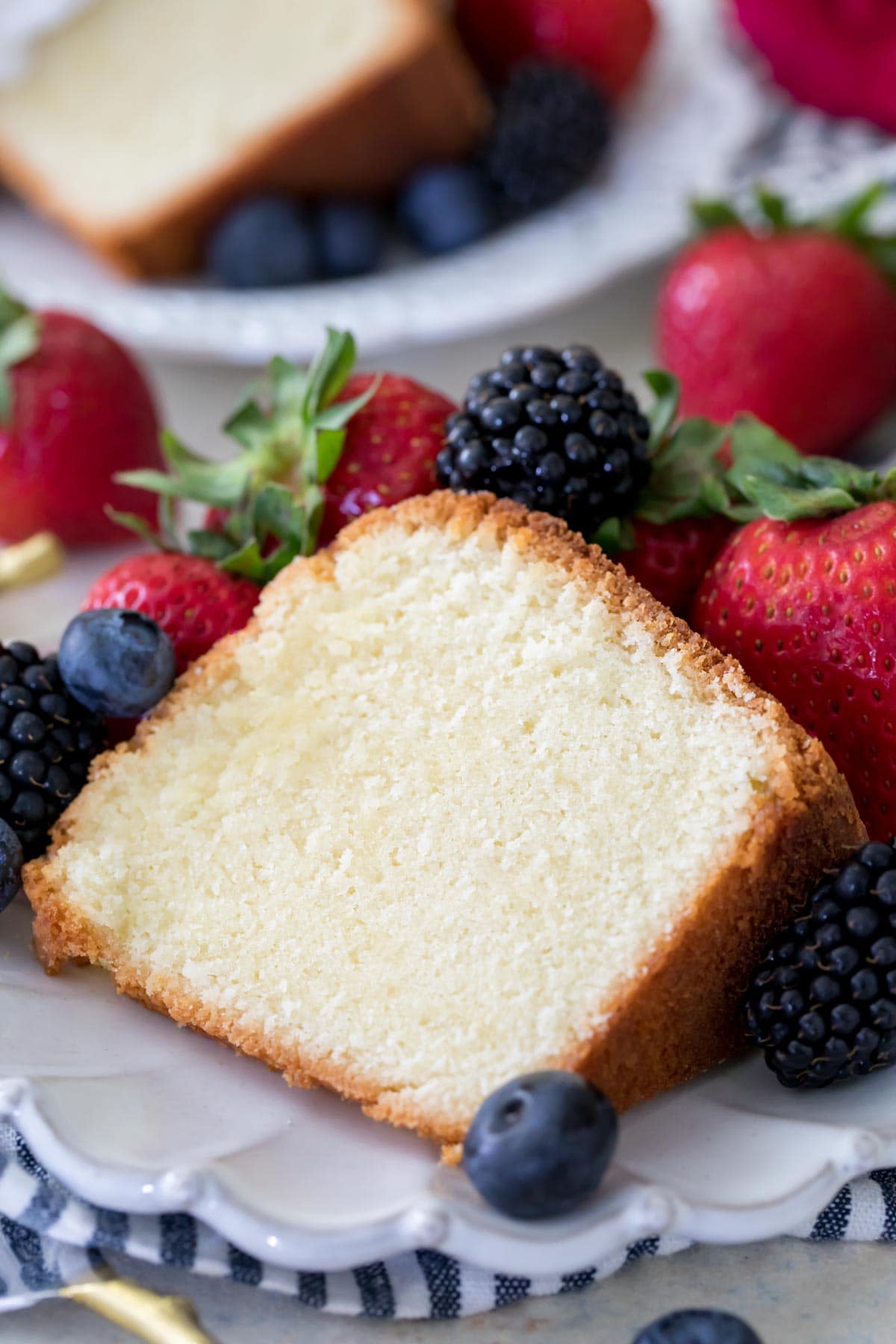
Traditional Pound Cake (Made Better!)
I’m not sure where pound cake rates in terms of your favorite cake recipes, but I’ll admit it had never been a top contender for in my household. Humble and frosting-less, sure I would have a slice, but nobody in my house ever really got excited about pound cake, often overlooking it for light and fluffy angel food cake or prettily iced layer cakes.
If your experience with pound cakes of the past is anything like mine, you’re in for a real treat today. I set about developing this recipe with a mission, determined to perfect a pound cake that was simple and not overly complicated, one that didn’t stray too far from the traditional version (no fancy or unusual ingredients) but at the same time put all of its predecessors to shame.
Here you have it. Perfectly balanced, rich and sweet, my pound cake is so buttery and soft that melts in your mouth, and it’s anything but boring. It’s a heavy cake (as pound cakes should be!) with a dense, velvety crumb, but there’s nothing dry or crumbly about it.
While this cake can hold it’s own, it’s even better when served with homemade whipped cream and fresh fruit. It would also pair well with a spoonful or two of lemon curd (a great way to use up some leftover egg yolks!).
Break out your bowls–you’re going to need a big one–and let’s talk about what it is that makes this cake so perfectly special and irresistible.
What You Need (and What You DON’T)
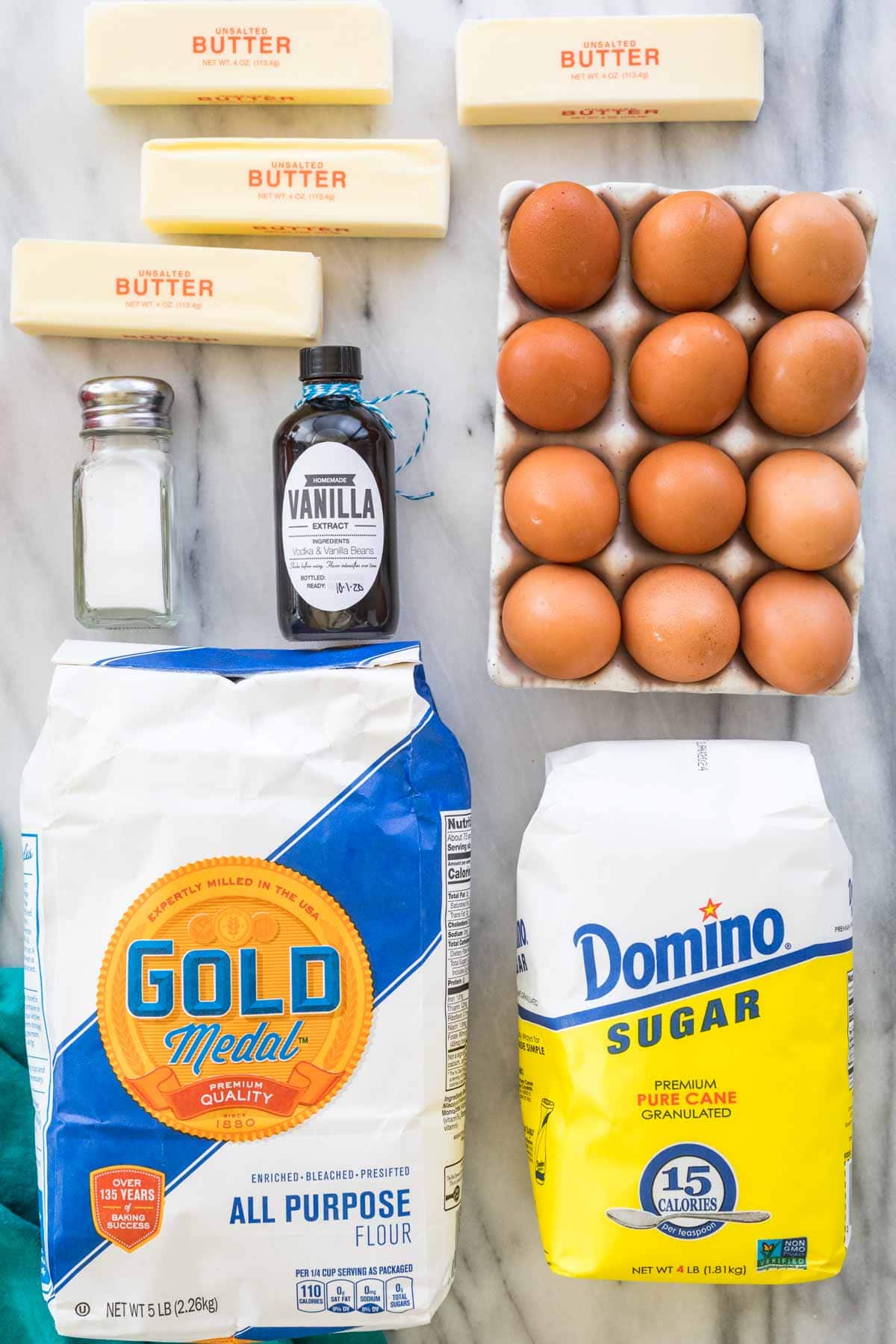
Pound cake has traditionally been made with a pound each of butter, sugar, eggs, and flour. When developing my recipe, I wanted to stay as true as I could to the traditional version, but some small adjustments were in order for the absolute best flavor (I mean, hello, vanilla extract!). The result is a soft, buttery crumb that’s perfectly dense without being at all dry or crumbly.
- Butter. Unsalted butter works best for this cake. It should be softened, but not so soft that it’s greasy, melty, or oily.
- Sugar. We stick with tradition and use regular granulated sugar only in this cake. Make sure to whip your butter and sugar until fully incorporated and fluffy before you move to the next step.
- Eggs. You will need six whole eggs and six additional egg yolks. It might seem like a lot, and it is, but trust me! The extra yolks help to keep the cake crumb moist with almost custardy undertones/flavors. We omit extra whites because they would make the cake crumb too light (remember, this is a dense cake!) and could even make it dry. This cake is perfect for using up extra yolks from another recipe! Save your extra egg whites to make meringue, pavlova, or Eton mess!
- Vanilla. You’re going to add a whole tablespoon of vanilla to this cake batter. This may seem like a lot, but I promise it’s just the right amount! PS. If you have a batch of homemade vanilla extract sitting in your cabinet, this is the time to bring it out!
- Salt. For flavor, I add a little salt.
- Flour. I specificaly developed this recipe to be perfectly soft and tender using plain ol’ all-purpose flour, but include notes in the recipe in case you’d like to substitute cake flour. Make sure you know how to measure your flour properly, or may end up with a dry cake. One more thing that I cannot stress highly enough: do not, under any circumstances, use self-rising flour. Your cake will almost absolutely overflow.
You may notice that my pound cake recipe does not use baking powder. This is intentional! Pound cake ought to have a dense crumb, and baking powder serves to lighten a cake’s crumb and help it rise. The eggs in our recipe work all of the rising-magic that we need, and not only would adding baking powder make the cake crumb too light (best-case-scenario), you’re also bound to find it’s overflowed all over your oven when the baking time has elapsed.
SAM’S TIP FOR LEMON POUND CAKE: I’ve received lots of requests for how to make a lemon version of this pound cake recipe. While you could just swap out the vanilla extract for lemon, it’s not going to taste as bright and sunny as you’re used to. I have a separate lemon pound cake recipe that packs lots of lemon flavor and is draped in a stunning white glaze. I highly recommend you try it!
As always, this is just an overview of the ingredients I used and why. For the full recipe please scroll down to the bottom of the post!
How to Make Pound Cake
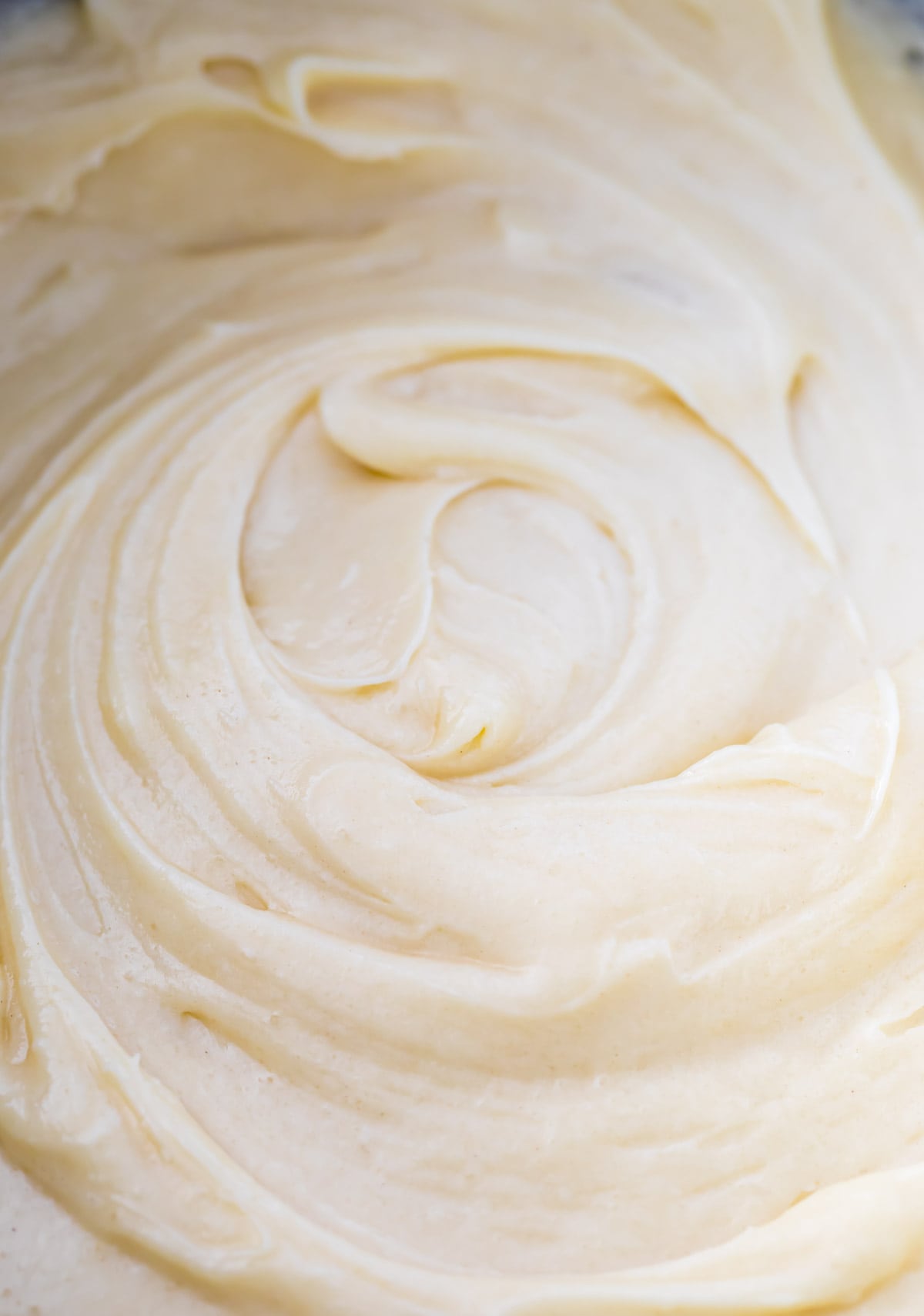
- Grease and flour your baking pan. Shake out any excess flour and set aside.
- Beat the butter until smooth, then add sugar. Cream until light and fluffy.
- In a separate bowl, combine eggs, egg yolks, vanilla, and salt. Slowly drizzle egg mixture into your butter mixture with mixer on low speed. Pause to scrape sides and bottom of the bowl, then increase speed and beat for another 1-2 minutes.
- Reduce speed to low and gradually add flour. Scrape and stir again on medium speed until well-combined, then beat for another minute. You should have a completely smooth, uniform batter. Pour batter into prepared pan, smoothing the top.
- Bake in 350F oven for an hour and ten to an hour and fifteen minutes. Test with a wooden skewer for doneness.
- Cool for 20 minutes, then run a knife around the sides and center of the pan before carefully inverting onto a cooling rack. Allow to cool completely before serving.
SAM’S TIP: To test if your cake is finished, the best method is to use a long wooden skewer (like the kind used for shish-kebabs) as this batter is so thick that a toothpick just won’t cut it. Insert the skewer into your cake and check it for moist crumbs. If you have wet batter on your skewer, your cake needs to bake longer, but if there are a few moist crumbs then it’s time to pull that cake out of the oven! The cake is going to continue to bake while it cools, so if you pull out a completely clean skewer from your cake, it’s already at risk of being over-baked and dry, so you want to retrieve your cake from the oven before it hits that point.
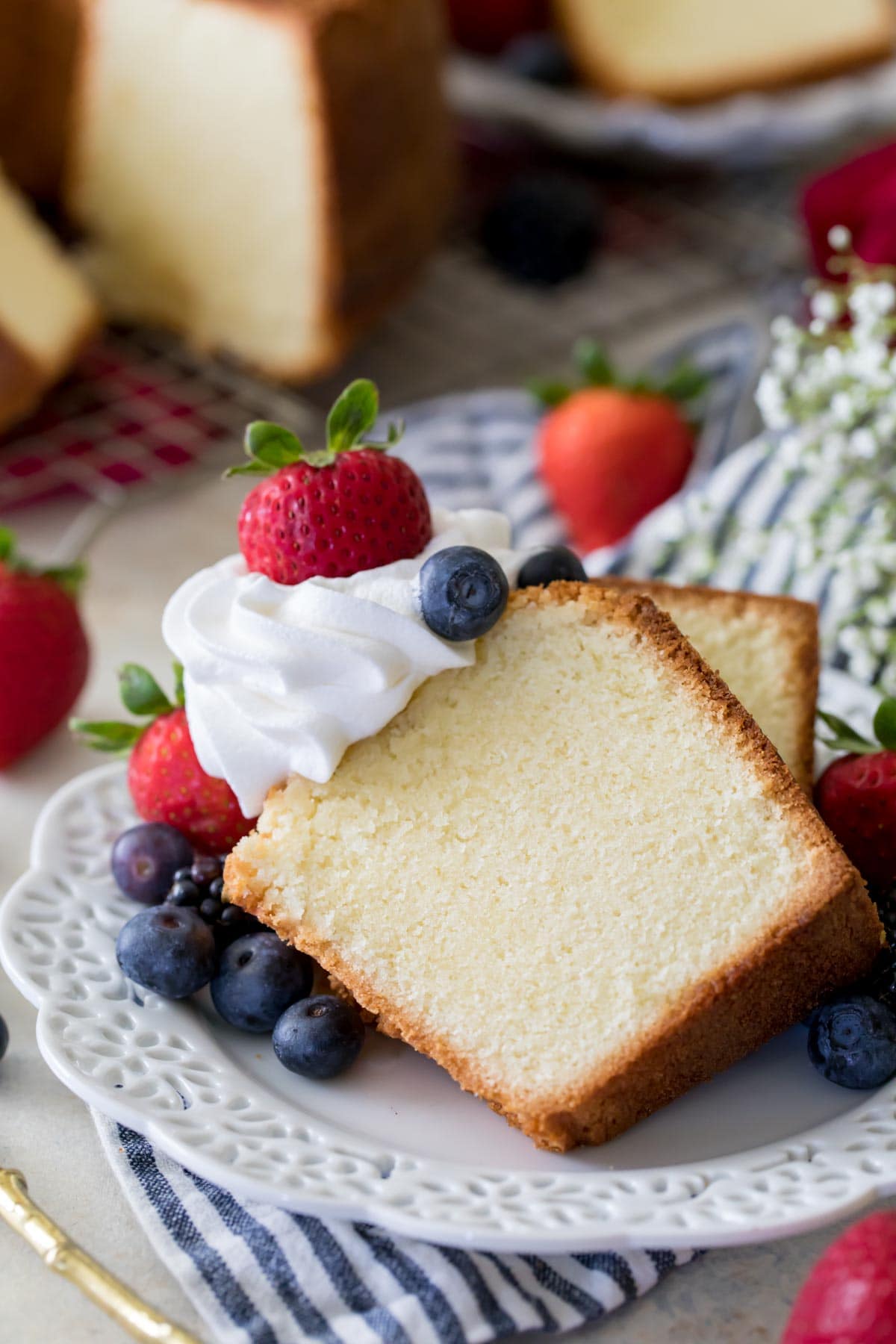
Frequently Asked Questions
While this recipe was very deliberately developed to be moist, the most important thing when baking your pound cake is to make sure that you do NOT over-bake it. I recommend making sure your oven is not running hot (I keep two oven thermometers in my oven at all times just to make sure my oven display is telling me the truth) and then checking your cake earlier rather than later. Because of its thick batter and the sheer volume of batter, it’s going to take quite a while in the oven, probably an hour and ten to an hour and fifteen minutes. I check my cake at one hour and then return it to the oven in about 5-minute increments until it’s finished baking.
This cake was originally made with a pound each of butter, sugar, eggs, and flour, and so the name pound cake was born. Crazy stuff, huh? 😉
This pound cake should not overflow if prepared as written and baked in the proper-sized pan (indicated in the recipe card). I have found that some people have had their cakes overflow, and in each instance this has happened because they had substituted self rising flour, used 12 whole eggs, or added baking powder to the recipe. Please do not make any of these alterations.
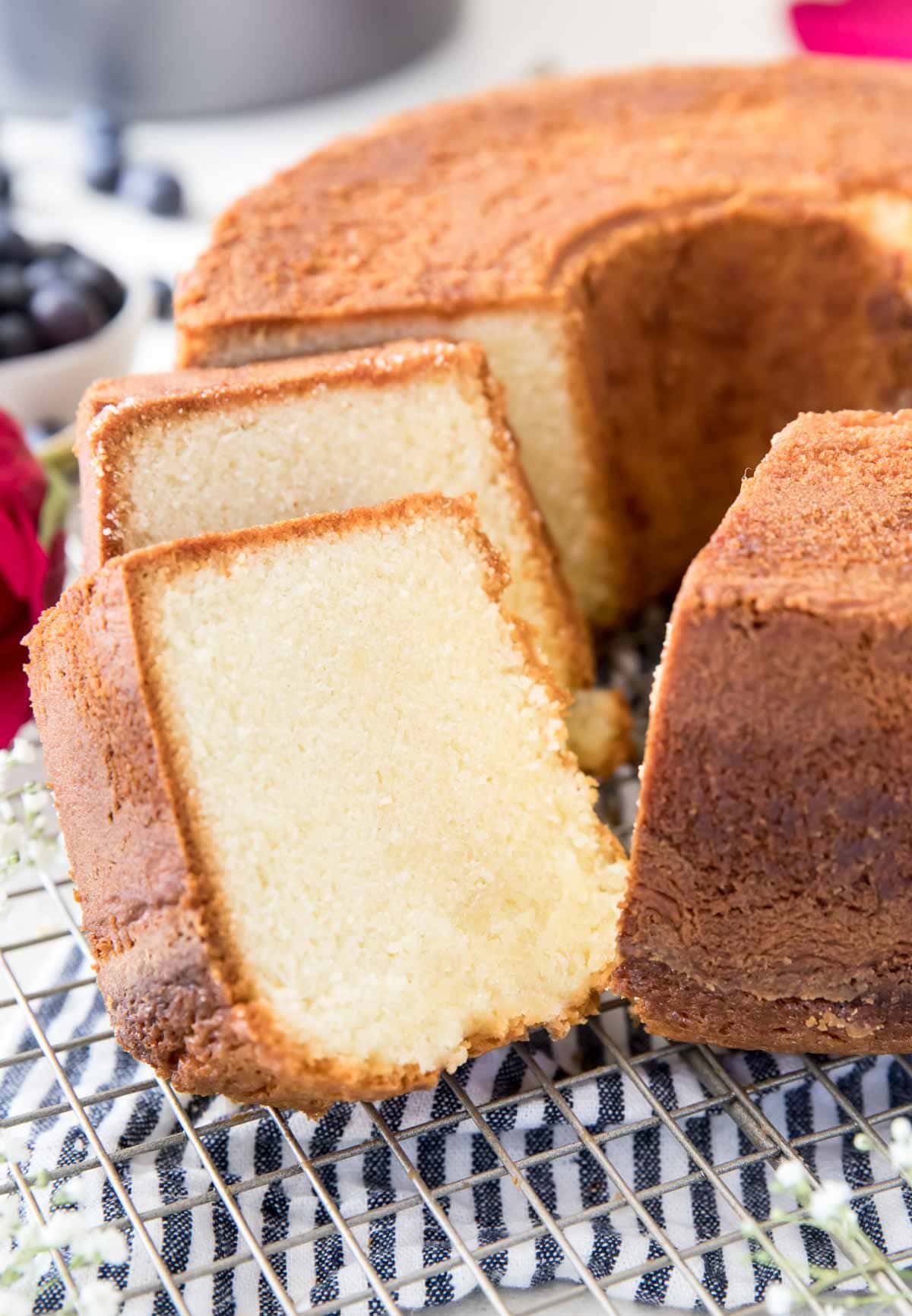
Enjoy!
More Classic Cakes to Try:
Let’s bake together! I’ll be walking you through all the steps in my written recipe and video below! If you try this recipe, be sure to tag me on Instagram, and you can also find me on YouTube and Facebook
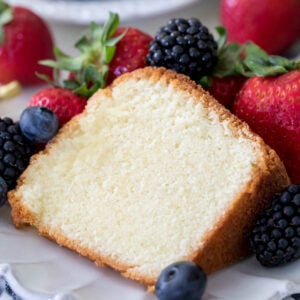
The Perfect Pound Cake Recipe
Ingredients
- 2 cups (455 g) unsalted butter softened
- 3 ½ cups (700 g) granulated sugar
- 6 large whole eggs¹
- 6 large egg yolks¹ (these 6 egg yolks are in addition to the 6 whole eggs listed above)
- 1 Tablespoon vanilla extract
- 1 teaspoon salt
- 3 ½ cups (438 g) all-purpose (plain) flour²
Recommended Equipment
- 10" tube pan or 12-cup bundt pan (must hold 12 cups batter)
Instructions
- Preheat your oven to 350F (175C) and generously grease (with shortening) and flour a 10 inch tube pan or 12 cup bundt pan (pan must be able to hold 12 cups). Shake out excess flour and set aside.
- Place your butter in a large bowl (this recipe makes a lot of batter! I recommend using a stand mixer if you have one) and use an electric mixer to beat the butter until it is creamy and smooth.2 cups (455 g) unsalted butter
- Scrape down the sides of the bowl and add the sugar. Beat until the ingredients are well combined and light and fluffy (about 1-2 minutes).3 ½ cups (700 g) granulated sugar
- In a separate, medium-sized bowl, combine your eggs, additional egg yolks, vanilla extract, and salt.6 large whole eggs¹, 6 large egg yolks¹, 1 Tablespoon vanilla extract, 1 teaspoon salt
- Use a fork to lightly beat the eggs and yolks until all egg yolks are broken up and salt and vanilla are incorporated.
- With mixer on low speed, slowly pour egg mixture into your batter, allowing it to gradually become incorporated (don’t pour all the egg mixture in at once, if you can’t manage a steady stream then add the egg mixture in about 6 parts, allowing each part to become well incorporated before adding more). Once all of the egg mixture is incorporated, pause to scrape down the sides and bottom of the bowl, then increase speed to medium-high and beat for another 1-2 minutes.
- Reduce mixer speed to low and gradually, about ¼ cup at a time, add flour to the batter until all has been added.3 ½ cups (438 g) all-purpose (plain) flour²
- Scrape down the sides and bottom of bowl and stir again on medium speed until well-combined and beat for another minute.
- Spread batter evenly into prepared tube pan, use a spatula to smooth the surface of the batter.
- Transfer to 350F (175C) oven and bake in the center rack of your oven for an hour and ten to an hour and fifteen minutes or until a wooden skewer inserted in the center of the thickest part of the cake comes out clean or ideally with a few moist crumbs (do NOT over-bake this cake or it will be dry)
- Allow cake to cool for at least 20 minutes then run a knife around the sides of the tube pan and the center.
- Carefully invert pound cake onto a cooling rack and allow to cool completely before serving.
Notes
¹Eggs
A lot of people have had questions about how many eggs to use. You need a total of 12 eggs for this recipe BUT you are only going to be using 6 whole eggs and then another 6 egg yolks. Meaning you will be discarding 6 egg whites (or save them to make meringue cookies or my white cake).²Cake Flour
If you’d like, you can substitute cake flour. If measuring your flour by weight (which you really should be!) you can do a straight 1:1 substitute for cake flour. If measuring by cups you will need 3 ¾ cup + 2 Tablespoons of cake flour. This cake will turn out just as well; slightly softer, a smidge less dense, but still delicious. Just like with using all-purpose flour, you DO NOT need to add baking powder to this recipe if you use cake flour. Also worth noting: DO NOT UNDER ANY CIRCUMSTANCES USE SELF-RISING FLOUR.Nutrition
Nutritional information is based on third-party calculations and should be considered an estimate only. Actual nutritional content will vary based upon brands used, measuring methods, cooking method, portion sizes, and more.

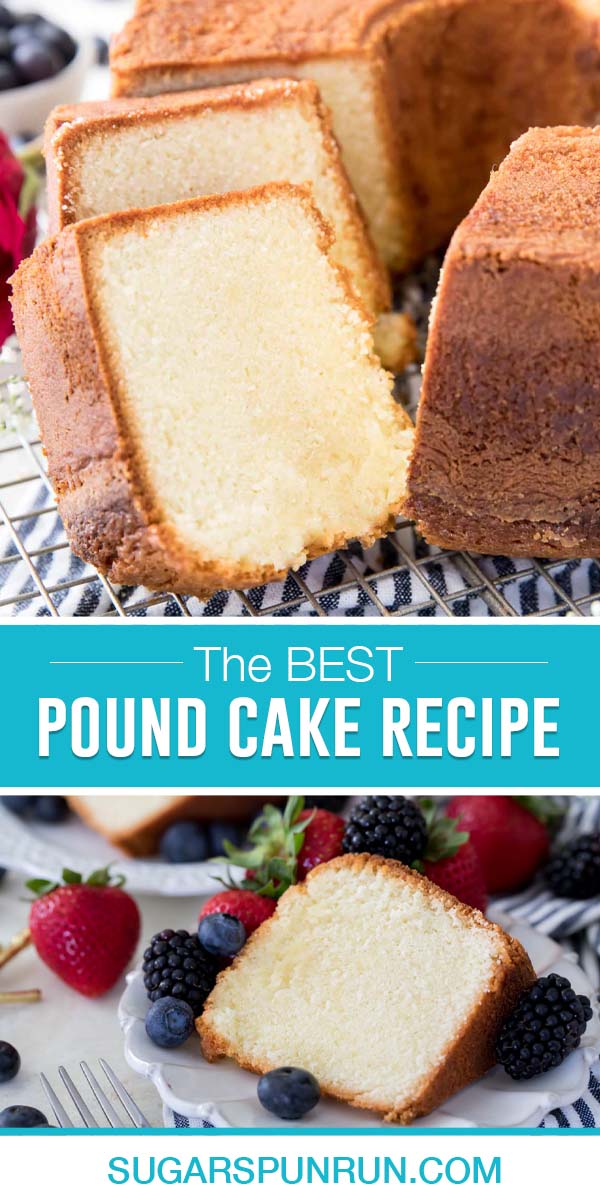
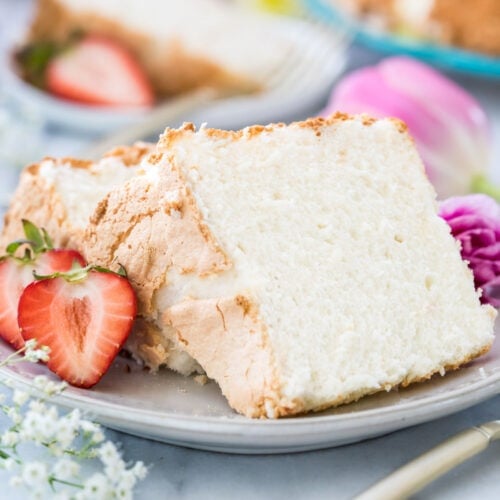
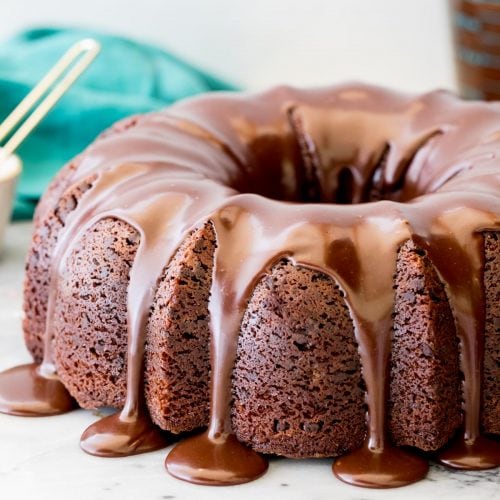
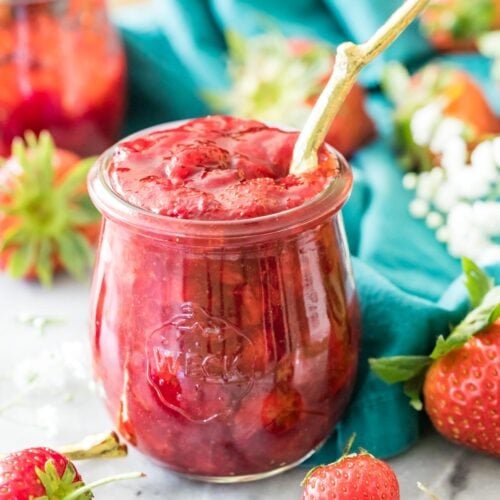
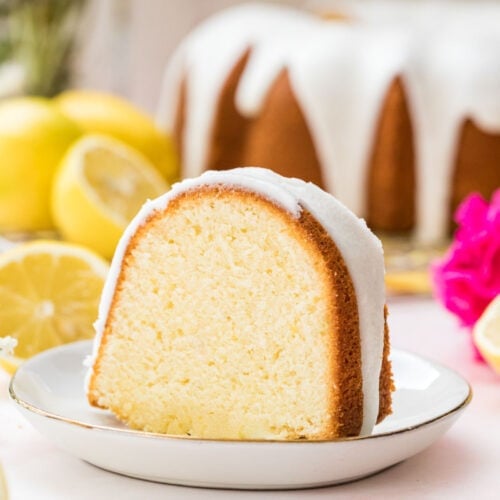
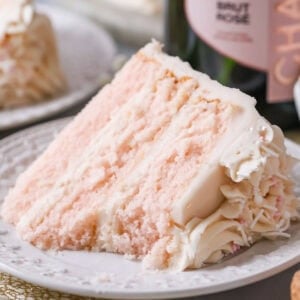
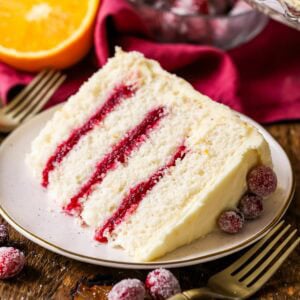

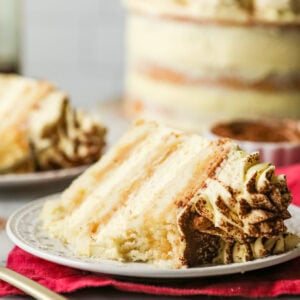
Becky Bailey
BEST Pound Cake I have ever tried-and I’ve tried at least twenty different recipes! Perfect crumb, delicious flavor. A real keeper!
Madison
The cake was good but when I baked it at 350 in the Bundt pan the outside browned really fast and by the time the middle was done the outside browned side was almost burnt. I couldn’t take it out any earlier because there was still a lot of batter on the skewers.
Sam Merritt
That’s quite odd, Madison! Is your oven temperature accurate? It sounds like it may be running a little hotter than it says it is. 🙁
Kim
I LOVE THIS RECIPE! I’ve used this recipe for the last 2 yrs and the cake comes out perfect every time. Today I’m making key lime pound cake.
Helen Azevedo
Hi I tried your recipe today followed it exactly it had a nice rise in the oven and the top got really brown however I liked the crunchy top since it is a lot of batter it was not ready in 1 hour and 15 minutes it took one hour and 25 minutes and my ovens are new and temp was right overall it did taste nice but as mentioned by others a bit too sweet
Carol dantzler
My mawmaw always added almond extract with her vanilla. If I do that should it be 50/50 or a different ratio?
Sam Merritt
Hi Carol! I would probably use less almond extract as it’s a bit more potent than vanilla and could overwhelm the cake. How much you use is going to be personal preference but I would start with less and add more if needed. 🙂
Kim
Tried this recipe, followed exactly as directed but the “top” when in pan crusted and got brown really quickly. It was also very sweet. I used tin foil to tent it to keep from browning anymore. It still tastes good, just crunchy and sweet
Ali
But if I followed the recipe exactly as written and still had those issues then how is that my fault and not the recipe? It needed to call for a larger pan due to the amount of batter. The next time I tried it (and have over the past few years) I adjusted pan size and golly gee, no issues. But you go, girl.
Sam Merritt
Hi Ali! Whew, sensing a lot of hostility here. I’m sorry you had trouble with the pan size. The recipe was tested in the 12-cup bundt pan listed (and that’s the one used in the video), so the batter should fit without issue. Since the amount of batter never changes when made according to the recipe, needing a larger pan would almost defy the laws of physics—but I’m glad you found a solution that works for you! My recommendation would be to double-check that your 12-cup pan actually holds 12 cups (see if it can hold 12 cups of water), I suspect it’s not as large as you think. Anyway, I’m glad you’re still enjoying the recipe!
Sam Merritt
Hi Brittany! What went wrong? How was it horrible? I can likely help you troubleshoot any issues you may have had.
Mia
I tried the recipe exactly and it turned out soggy, too buttery, and way too sweet. wasted 12 eggs
Sam Merritt
I’m so sorry this happened, Mia! Did you use a skewer to make sure it was baked all the way through? Did you make any adjustments? Just to clarify you did not use 12 whole eggs, did you?
sidney bales
You might re-think the 350 oven. The cream cheese Pound cake has 300 degrees. I made it with a 350 oven and it was too hot. (it could have been my oven too.)
Sam Merritt
Hi Sidney! I personally bake mine on 350 and have multiple thermometers to make sure my oven temperature is accurate. I would not advise baking it on 300. 🙂
Sidney Bales
I’m not trying to pick a fight, just trying to understand. Why does your Cream Cheese Pound cake bake at 300? Other pound cakes recipes I found have a 325 degree oven.
I did find that my oven was calibrated 25 degrees too hot. So I recalibrated my oven and going to try again. Thank you for your response.
Sam Merritt
It’s just the temperature that I have found to work best for this cake. I do test them multiple ways and this one was the winner. 🙂
Cj12
Can you use this recipe to make cupcakes instead of a cake? Or would adjustments need to be made?
Emily @ Sugar Spun Run
Hi! This should work just fine as cupcakes. We haven’t tried it personally but we think bake time would be around 17 minutes 🙂
Renee
Absolutely perfect and once again, a thumbs up from my polish mom who always thought our traditional recipes handed down from generations ago were the best!